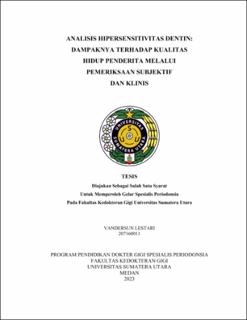Analisis Hipersensitivitas Dentin: Dampaknya terhadap Kualitas Hidup Penderita melalui Pemeriksaan Subjektif dan Klinis
Analysis of Dentin Hypersensitivity: Impact on the Quality of Life of Patients through Subjective and Clinical Examination

Date
2023Author
Lestari, Vandersun
Advisor(s)
Wulandari, Pitu
Rachmawati, Yuanita Lely
Metadata
Show full item recordAbstract
Introduction: Dentin hypersensitivity (DH) manifests as a sharp pain elicited by
external stimuli, typically associated with the exposure of dentin tubules. Gingival
recession (GR) is also known to cause exposure of tooth roots and multiple studies
suggest potential synergistic effects between the two conditions. DH also significantly
influence individuals' well-being. There isn’t any specific validated questionnaire in
Indonesia which could be used to measure their quality of life. Incorporating the Visual
Analog Scale (VAS) to quantify pain intensity and the short version of Dentin
Hypersensitivity Experience Questionnaire (DHEQ-15) to capture the impact on
patients' lives, we aim to provide a deeper understanding by adapting the DHEQ-15.
Objective: This study aims to adapt and validate DHEQ-15 into Indonesian version
and analyze the relationship between DH with multiple aspects such as degree of GR,
pain associated with DH quantified in VAS and to explore the impact of DH on patients'
daily lives using the DHEQ-15. Methods: DHEQ-15 was translated into Indonesian
language using forward-backward process and validated in a cross-sectional study
consists of subjective and clinical examination. The reliability and validity of the
adapted DHEQ-15 were evaluated through internal consistency, test-retest reliability
and discriminant validity. Relation between DH and DHEQ-15, DH and VAS, GR and
VAS and between VAS and DHEQ-15 were analyzed statistically. Results: 134 patients
with DH were recruited to be examined and to complete the adapted questionnaire. The
Indonesian DHEQ-15 demonstrated very good internal consistency (α = 0.936) and
test-retest reliability revealed excellent reproducibility (ICC = 0.936). In terms of
discriminant validity, DH levels measured in Schiff Scale (SS) are significantly
different when compared to DHEQ-15 scores. Spearman test showed significant
positive correlations detected between DH and multiple parameters (p<0.05).
Conclusion: This study provides evidence supporting the reliability and validity of the
Indonesian DHEQ-15 for use in Indonesia. GR and VAS proves to be a beneficial
parameter for assessing pain intensity in DH patients, while the DHEQ-15 offers a
comprehensive understanding of the impact of DH on patients' quality of life.
Collections
- Master Theses [39]
